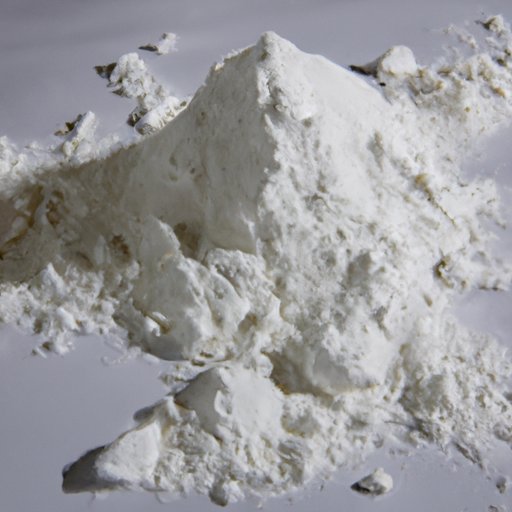Introduction
A mineral is a naturally occurring material which is formed through geological processes. Minerals are often characterized by their crystal structure, chemical composition, and physical properties. One mineral that has been utilized for centuries is talc, which is composed primarily of magnesium, silicon, and oxygen. In this article, we will explore the mineral properties of talc, its various uses in industry, the history of talc mining, health risks associated with talc, and the global market for the commodity.

Exploring the Mineral Properties of Talc
Talc is a hydrated magnesium silicate mineral that typically appears as an off-white or greenish powder. It is composed of magnesium, silicon, and oxygen atoms, and is classified as a phyllosilicate mineral. The chemical formula for talc is Mg3Si4O10(OH)2. Talc has a Mohs hardness of 1 on the Mohs scale, which is the lowest hardness of any known mineral. This property makes talc one of the softest minerals on earth.
Talc has several unique physical properties. It is insoluble in water, and has a low thermal conductivity and electrical resistivity. Talc is also relatively lightweight, with a specific gravity of 2.7 to 2.8. Additionally, it has a low refractive index and a moderate surface tension.
Talc has a variety of chemical properties. It is composed of primarily magnesium, silicon, and oxygen, and is highly chemically inert. Talc is resistant to most acids and bases, and does not react with other chemicals. Additionally, it has a high dielectric strength and is resistant to corrosion.
An Overview of Talc’s Uses in Industry
Talc has been used in a variety of industries for centuries. It is an important industrial mineral due to its unique physical and chemical properties. Some of the most common uses for talc include: cosmetics and personal care products, pharmaceuticals, plastics and polymers, fertilizers and soil conditioners.
Cosmetics and personal care products are one of the largest markets for talc. Talc is used in a variety of products such as makeup, body powders, and baby lotions. Talc helps to reduce oiliness and absorb moisture, which makes it an ideal ingredient for many cosmetic products. Additionally, talc is used as a filler in many pharmaceuticals, such as aspirin and ibuprofen. Talc is also used in plastics and polymers to improve their mechanical and electrical properties. Finally, talc is used in fertilizers and soil conditioners to improve soil fertility.
Examining the History of Talc Mining
Talc has been mined for centuries, with evidence of its use dating back to ancient Egypt. Early mining practices were primitive compared to modern techniques, and often involved manual labor and rudimentary tools. Talc was initially mined in Europe and North America, but the industry has since spread to Asia, Africa, and South America.
Today, talc is one of the most widely produced minerals in the world. According to the US Geological Survey, global production of talc was estimated to be over 6 million metric tons in 2019. China is currently the largest producer of talc, followed by the United States, India, and Finland.
As with any form of mining, there are environmental impacts associated with talc extraction. Mining can lead to deforestation, air and water pollution, and soil contamination. Additionally, some talc mines contain asbestos, which can be hazardous if inhaled. Stringent regulations and proper safety protocols are necessary to ensure that the environmental impact of talc mining is minimized.

Investigating the Health Risks Associated with Talc
There have been numerous studies conducted to investigate the potential health risks associated with talc. Inhalation of talc particles can cause respiratory irritation and inflammation, as well as asthma-like symptoms. Additionally, direct contact with talc can cause skin irritation and may increase the risk of developing eczema. There is also evidence to suggest that talc can increase the risk of certain types of cancer, including ovarian cancer and mesothelioma. However, further research is needed to fully understand the potential health risks of talc.
A Guide to Identifying and Collecting Talc
Talc can be identified visually by its softness and white color. Talc is easily scratched and marked, so it is important to handle it carefully. Additionally, talc can be tested using a variety of methods, such as X-ray diffraction, infrared spectroscopy, and electron microscopy. Collecting talc requires special equipment and safety precautions, as it can be hazardous when inhaled.

Exploring the Global Market for Talc
The global market for talc is complex and ever-evolving. Supply and demand are the main drivers of the price of talc, although other factors such as trade regulations and political instability can also affect the market. Additionally, the development of new technologies and applications for talc can have a significant impact on the price of the commodity.
According to a report from Grand View Research, the global talc market is expected to reach USD 3.45 billion by 2025. Growing demand from the cosmetics and personal care industry is expected to be a major driver of growth for the market. Additionally, increasing awareness about the health benefits of talc is expected to spur demand for the mineral.
Conclusion
In conclusion, talc is a mineral composed of magnesium, silicon, and oxygen atoms. It has several unique physical and chemical properties, which make it an important industrial mineral. Talc is used in a variety of industries, including cosmetics and personal care products, pharmaceuticals, plastics and polymers, and fertilizers and soil conditioners. Talc has been mined for centuries, and the global market for the mineral is expected to continue growing in the coming years. Lastly, talc has been linked to certain health risks, so it is important to take proper safety precautions when handling the mineral.
(Note: Is this article not meeting your expectations? Do you have knowledge or insights to share? Unlock new opportunities and expand your reach by joining our authors team. Click Registration to join us and share your expertise with our readers.)
